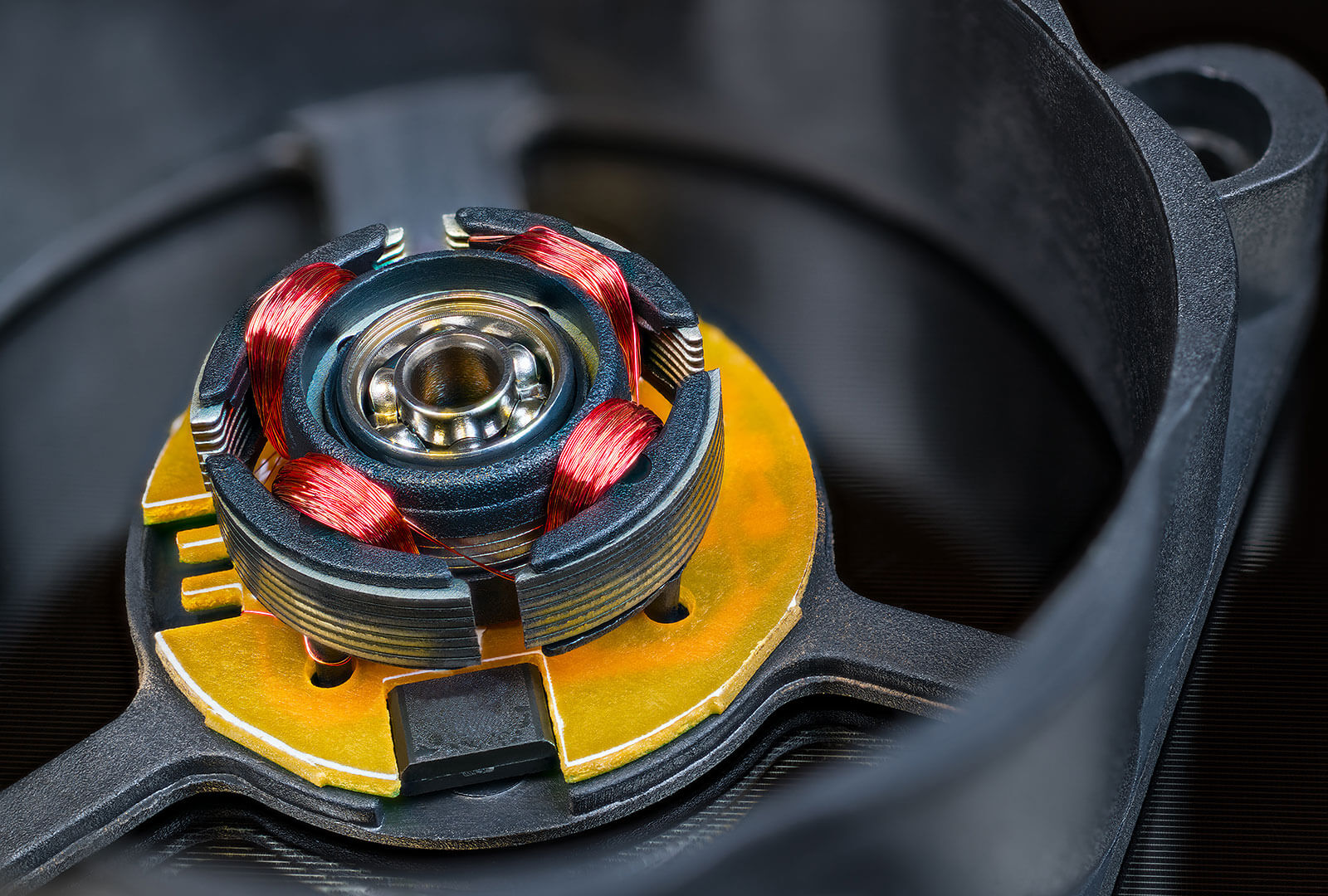
Permanent Magnets
Permanent magnets bear their name because they exhibit permanent magnetic forces without having to depend on external influences such as electrical voltage. The strongest permanent magnets contain a high proportion of rare earths and are particularly in demand for applications where high magnetic power is required in a small volume. In addition to consumer electronics, the most important uses for permanent magnets include climate-friendly technologies such as electromobility and wind power. As these become increasingly widespread, the demand for permanent magnets and rare earths overall is growing.
The following rare earths are often used in permanent magnets:

Catalysts
Catalysts increase the speed of a chemical reaction and have a wide range of applications in various industries. Perhaps the best known is the automotive catalytic converter, which converts combustion pollutants into non-toxic residues. This conversion process is made possible with the help of rare earths. Since conventional vehicle models will continue to dominate both existing and new registrations for the foreseeable future, the demand for rare earths will also remain high. In rubber production, neodymium, lanthanum, and praseodymium are used as catalysts. Rubber, in turn, is a raw material used in the production of car tires. Catalysts containing rare earths are also involved in the refining of crude oil.
The following rare earths are commonly used in catalysts:
Lanthanum, Cerium Neodymium, Praseodymium, Samarium, Ytterbium

Polishes
Polishes give glasses and mirrors their shine and prevent them from fading. The automotive industry relies on rare earth polishes for windscreens and mirrors. These polishes are used on scratched surfaces, as they are many times finer than conventional alternatives. The higher the rare earth content, the greater the effect and the higher the price. In addition to automotive glasses and mirrors, optical lenses and other special glasses also owe their flawless shimmer to rare earths.

Metal Alloys
The first alloys were produced thousands of years before Christ. Since then, the knowledge of how to combine metallic materials has been continuously refined. The areas of application are numerous, and rare earths often play an important role. For example, they increase the strength of steel and are used together with magnesium in the production of aircraft engines. Another area of application is the production of flints. For this purpose, so-called mixed metal is used, a rare earth alloy containing small amounts of iron and magnesium.
The following rare earths are often used in metal alloys:
Cerium, Ytterbium, Dysprosium, Terbium, Neodymium, Praseodymium

Batteries
Battery storage systems are fundamental to the energy transition. Both hybrid and fully electric vehicles use them as an energy supply. While fully electric vehicles use lithium-ion batteries, manufacturers of hybrid vehicles rely on nickel-metal hydride batteries. An alloy containing rare earths, among other materials, is used in the electrodes of these batteries. These types of batteries are also used in electric toothbrushes, flashlights, and toys.
The following rare earths are used in batteries:

Glass
The story of glass is thousands of years old. Countless modern technologies require it, from the special glass used in space travel to the touch displays in cellphones to the lenses in eyeglasses. Rare earths are essential to these applications. Rare earths color and decolorize glass, absorb UV light, provide a high gloss in polishes, and protect glasses and mirrors from dulling. The ceramics industry values rare earths as colorants and polishing agents. The laser industry uses rare earths as doping agents for glass fibers. Rare earths also increase the data transmission performance of fiber-optic cables.
The following rare earths are used in glass:

Ceramics
Ceramics are thousands of years old but also highly modern. In certain special ceramics, rare earths improve properties such as resistance to heat and physical stress. Important applications for rare earths in ceramics include the manufacture of medical implants and fuel cells, the latter of which use hydrogen to generate electrical energy. According to the German Mineral Resources Agency, the ramp-up of hydrogen technology in mobility and industry is creating an emerging supply risk for the rare earths required for ceramic applications.

Lighting
Fluorescent tubes have long been the standard for lighting public buildings and workplaces. In addition to mercury, tin, and copper, rare earths were used in manufacture. Rare earth elements are still used in modern energy-saving lamps and LED lights. In the latter, rare earths ensure that the blue light emitted by light-emitting diodes is also converted into white, green, and red light. Rare earths are used in devices with picture tubes, as well as in tablets and smartphones, where they produce red pixels.
The following rare earths are used in lighting:
Cerium, Dysprosium, Erbium, Europium, Lanthanum, Lutetium, Gadolinium, Neodymium, Praseodymium, Terbium, Thulium, Ytterbium, Yttrium

Pigments
Unlike dyes, pigments remain solids in the objects they color. Pigments can be used to add color to enamels, ceramics, and glass. Rare earths play an important role here. They give materials certain tones. The coloring of glass was one of the first applications of rare earths. Praseodymium is used for yellow, blue, and sometimes green coloration. Yellow tones can also be produced by using holmium. Neodymium produces shades ranging from pink to violet. Cerium is used to color enamel orange.
The following rare earths are used in pigments:
Cerium, Erbium, Europium, Gadolinium, Holmium, Neodymium, Praseodymium, Samarium

Wind Power
The use of wind to generate rotational energy dates back to the seventh century AD, when the first windmills were built in Persia. Today, the generators in modern wind turbines convert the rotation of the rotors into electrical energy. In many wind turbines, these generators use powerful permanent magnets made of rare earths. Since there is no need for a gearbox in this turbine design, the systems are easy to maintain and comparatively quiet. Along with electromobility, wind energy is considered to be the most important factor in the increasing demand for rare earths.
The following rare earths are used here in wind power:

Nuclear Power
In a nuclear reactor, energy is generated by splitting the atomic nuclei of substances such as uranium. While the final nuclear phase-out was completed in Germany in 2023, this low-carbon form of energy generation is experiencing a renaissance in many other countries. As a result, the demand for rare earths could also continue to grow, as nuclear power is an area of application for this group of raw materials. Some rare earths are used in the control rods of reactors. These rods regulate the performance of the nuclear reactor and can shut it down if necessary.
The nuclear industry uses the following rare earths:

Water Electrolysis
As they work to create more climate-friendly technologies, several energy-intensive industries and manufacturers of heavy goods vehicles have high hopes for green hydrogen. This energy source is produced by water electrolysis, in which water is split into its component elements, hydrogen, and oxygen, using green electricity. Various rare earth elements are used as electrolytes in certain electrolyzers. Given the planned scaling-up of the hydrogen economy in many countries, the demand for certain rare earths could increase significantly.
The following rare earths are used in water electrolysis:

Electromobility
The first electrically powered vehicles were developed around 1850 and experienced their first heyday at the turn of the century. As we all know, cars with gasoline engines ultimately prevailed as the world’s favored mode of transportation. In recent years, however, the fight against climate change has given new life to electromobility. Alongside wind power, it is now considered the most important factor in the increasing demand for rare earths. In many EV models, rare earths are used in magnets found in drive motors that convert electricity into kinetic energy. Rare earths help give these magnets their highly desirable weight-to-power ratio.
The following rare earths are used in electromobility:

Aviation
Rare earth elements are used in civil and military aviation. According to a report by the US Congress, a single F-35 fighter jet contains almost 417 kilograms of rare earths. Most of them are permanent magnets used in electronics and landing gear motors, for example. In addition, rare earth alloys are used to make the wings and fuselage. These alloys are lighter than conventional alternatives but offer the same performance and increase the plane’s range by reducing fuel consumption. These raw materials are also used as catalysts in tire production.
Among others, the following rare earths used in aviation are:

Lasers
Laser beams are sharply focused electromagnetic waves. The industry uses lasers to cut, shape, weld, and coat materials. Lasers are also used in medicine—for example, in diagnostics, dermatology, dentistry, and surgery, where they enable high-precision, minimally invasive, and pain-free incisions. In the military, lasers are used in communication technology, for measurements, and as weapons. High-speed Internet also benefits from this technology, as laser diodes generate the optical signals in fiber optic cables.
The following rare earths are used in lasers:

Medical Technology
Medicine uses a variety of technical devices to prevent and treat disease. Tech that allows doctors to visualize the inside of the body – such as X-rays and magnetic resonance imaging (MRI) – uses rare earths. These elements increase the image quality in X-ray intensifier foils and contrast agents. MRI machines use permanent magnets containing rare earths. Rare earths are also in demand in other medical fields, such as nuclear medicine, where radioactive rare earths are used to fight cancer tumors via the bloodstream. Representatives of this group of raw materials are also used to manufacture prostheses and implants and for medical lasers.
The following rare earths are used in medical technology:

Semiconductors
Semiconductors are solids whose electrical conductivity lies somewhere between that of non-conductors (e.g., glass) and conductors (e.g., metals). Unlike metals, their conductivity increases as the temperature rises. These and other properties can be changed explicitly by introducing foreign atoms into the semiconductor material. Such doping enables the production of electronic components – including LEDs, microprocessors, solar cells, and lasers – that can fulfill various functions.
The following rare earths are used in semiconductors:
Terbium, Cerium, Erbium, Lanthanum, Neodymium, Praseodymium, Samarium, Scandium, Yttrium, Ytterbium
Raw Materials Trading Industrial Customers
TRADIUM trades in all industrially relevant rare earth oxides. Choose from a wide range of specifications and take advantage of the option to reserve batches for the long term.
Purchase of Physical Assets for Private Customers
Benefit as a private customer from the exciting market for rare earths as a physical asset. You can find out here what opportunities TRADIUM offers and what tax advantages a purchase of raw materials entails.